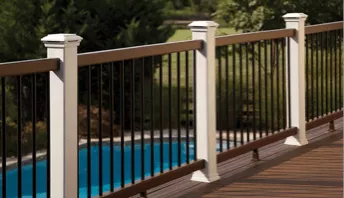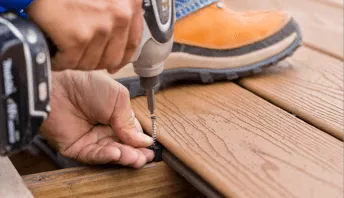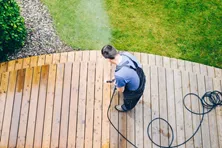Deck Post Repair: How to Fill Cracks in Deck Posts

Difficulty: EasyTime to completion: Less than 1 day
You love your deck and want to get as much use out of it as you can. It's your outdoor oasis where you spend time with friends and family, making memories that last a lifetime.
You love your deck and want to get as much use out of it as you can. It's your outdoor oasis where you spend time with friends and family, making memories that last a lifetime.
No matter how sturdy the wood is for the deck posts, the heat, cold, and weather may cause the wood to crack or split over time. Yes, the right kind of wood can resist rot, mold, and insects, but they can still split or crack.
You can repair the posts before the problem causes structural issues. Want to know how to fix a cracked deck post? Read our guide on deck post repair to help your outdoor space last as long as it possibly can.
Tools You’ll Need For Your Deck Post Repair
Before you start filling cracks in the deck post, assemble the tools and items you require for this simple project.
- Putty knife or spatula
- Timber filler or epoxy glue
- Clamps
- Sanding block
- 60-grit sandpaper
- 180-grit sandpaper
- Clean cotton cloth
- Paintbrush
- Decking oil
- Primer and paint or stain
- A ladder if you have a tall deck
We'll go over these tools in the order you need them from start to finish while showing you how to fix cracks in deck posts.
Steps to Repair a Cracked Deck Post
First, it’s necessary to determine whether the post is structurally sound. If the post is structurally compromised, then it can not be repaired. If the post is structurally adequate, then a cosmetic crack can be filled. We don't want anyone filling cracks and the deck falls down.
Now, we'll go over step-by-step instructions for fixing a cracked deck post before it gets damaged beyond repair and causes structural problems.
1. Inspect the Cracked Deck Post
Before you purchase any items you need for this project, inspect the cracked deck post. Where is the damage? Do the cracks run through the center or down the support post? Does the post seem as if it's about to fall apart with a simple touch or movement? Your deck post may be beyond repair if it moves too much or falls to pieces.
If your deck is tall or you have a multi-layered deck, you’ll need a ladder to fully inspect the deck posts. Please follow instructions and safety measures when getting on a ladder.
2. Choose the Right Type of Glue
Select a waterproof glue to fill in the cracks of the deck post. Read the label closely to make sure the product bonds to the wood. Otherwise, the glue won't work.
There are two main types of glue to look for at your local hardware store.
Powdered resin glue is perfect for wood because it doesn't discolor the wood, and it resists mold. You will need to mix the resin with the right amount of water until it forms a substance about the same consistency as syrup. It will be sticky as glue should be.
Epoxy should be used for this type of deck post repair when larger cracks are involved. This type of adhesive is stronger than resin glue and can even prevent further damage. Epoxy requires special handling, so please read the instructions carefully. Most epoxy dispensers offer an injectable adhesive that can reach deep into cracks to seal them permanently.
3. Fill in the Cracked Deck Post With Glue
Use a putty knife to spread the adhesive into the damaged and cracked deck post. Make the adhesive flush with the outermost part of the deck post. Once the cracks are filled in completely, use the putty knife to smooth out the surface of the deck post. Some of the glue will fill in the natural grain and gaps of the wood's surface.
4. Consider Using Clamps to Hold Wide Cracks Together
You'll need a large clamp or two to keep the post together if you have particularly wide splits or cracks. Tighten the clamps on each direction of the post until the post oozes some of the glue you put in earlier. Maintain the clamps’ pressure until the glue cures completely, typically in 24 to 48 hours, based on the manufacturer's recommendations.
5. Sand Away Any Excess Glue After It Cures
Now it's time to remove any excess glue on the outer edge of your split deck post. Find a small, handheld sanding block and put 60-grit sandpaper on it. Gently rub back and forth until the glue and wood are even with each other. Feather the edges with 180-grit sandpaper for a smooth finish. Wipe away any excess glue or sawdust with a clean, dry cotton cloth.
6. Seal the Repair on the Split Deck Post
Take a 1-inch paintbrush and dip it in decking oil. Cover the repair with a single coat of oil, let it dry thoroughly according to the manufacturer's instructions, and then cover the first layer with a second coat. Let the second coat dry completely. The deck oil will prevent moisture intrusions and seal the repair completely.
7. Paint or Stain the Repaired Deck Post

For a finishing touch, consider covering the deck oil with primer and paint or deck stain, depending on the current status of your deck. If it's painted, use primer and paint. If it's stained, use stain. If you haven't painted or stained your deck yet, now is a good time to think about doing that project so that your deck will last a lifetime and look great.
Want more deck ideas? Check out our list of how-to guides for additional information.
Get Started with Repairing Your Cracked Deck Post Today
It’s important to repair cracked deck posts as soon as you notice them before the problem gets worse. Replacing a post is more complicated, and more expensive, than repairing a cracked deck post. The goal of repairing is to leave the post in as you fix it.
If you determine your deck needs more than just repairs for the cracks, you might consider hiring a contractor to help. For more details, find a retailer with supplies for your deck or find a builder if you want a new deck installed or replaced.
How to Remove Moss & Algae from Your Deck
Moss and algae growth can be detrimental to the integrity of your deck if left untreated.
Preventing & Treating a Slippery Deck
Inclement weather can cause both wood and composite decks to become slippery and potentially unsafe. Learn how to prevent and treat a slippery outdoor deck at Decks.com.
Capped Composite Decking
What is capped composite decking? It's a great option if you like the look of wood but not the maintenance. Learn about capped composite at Decks.com.
Composite Decking Prices
Composite decking ranges in price from $2 to $6 per linear foot. Compare brands and costs with our composite decking pricing chart at Decks.com.
Types of Wood Decking Materials
There are many options for choosing the best wood for your deck, like pressure treated pine, cedar, redwood or mahogany. Compare types of wood at Decks.com.
More Helpful Resources
Explore Articles by Topic

Footings
Information related to installing frost footings for decks

Framing
Learn structural framing methods

Decking
Learn about wood and composite decking materials

Stairs
An in-depth look at the complex issue of how to build stairs

Railings
How to install guardrails and handrails to meet IRC code

Features
An overview on water drainage, benches, planters and lights

Design
The basics of deck design

Planning
Learn about permits and working with contractors

Porches & Patios
Build a covered deck to enjoy all seasons

Ledger
Proper attachment techniques

Care
Maintain your deck to maintain your investment

Materials
An overview on water drainage, benches, planters and lights
How to Remove Scuffs and Scratches from Composite Decking
Removing scuffs and scratches can help make your composite deck look like new. Learn how to fix and prevent your composite deck from future scratches.
How to Seal Your Deck & Best Deck Sealers
Once you clean or stain a deck, it is ready to be sealed. Learn how to properly seal your deck in order to protect it from damage caused by harsh climates and weather at Decks.com.
How to Pressure Wash a Deck
Pressure washing your deck is the best way to keep your investment looking like new. Learn how to properly clean your wood deck with these tips from Decks.com.
Is Trex Decking Worth the Investment? Expert Insights and Reviews
Discover why Trex decking is worth the investment. Learn about its durability, low maintenance, eco-friendliness, and the long-term value it adds to your home.
Gorilla Deck
Gorilla Deck Vinyl Decking is manufactured by Homeland Vinyl Products in Birmingham, AL.
Explore Articles by Topic

Footings
Information related to installing frost footings for decks

Framing
Learn structural framing methods

Decking
Learn about wood and composite decking materials

Stairs
An in-depth look at the complex issue of how to build stairs

Railings
How to install guardrails and handrails to meet IRC code

Features
An overview on water drainage, benches, planters and lights

Design
The basics of deck design

Planning
Learn about permits and working with contractors

Porches & Patios
Build a covered deck to enjoy all seasons

Ledger
Proper attachment techniques

Care
Maintain your deck to maintain your investment

Materials
An overview on water drainage, benches, planters and lights
















